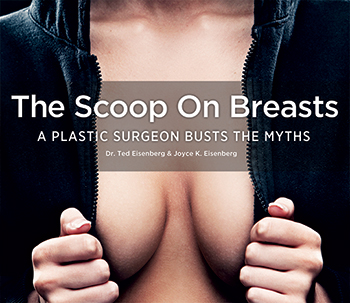Saline vs Silicone Breast Implants
There’s an opinion asserted by breast implant manufacturers and by many plastic surgeons that silicone gel breast implants are better than saline breast implants.
In my opinion, “It ain’t necessarily so.”
I’ve performed more than 7,000 breast augmentation surgeries, many of them with saline implants. My patients who chose saline have reported a high degree of satisfaction; it’s been rare for a woman to request that I change her saline implants to silicone.
![]()
Silicone gel implants may be stealing the spotlight, but saline breast implants still have much to offer. Here are seven reasons why:
A Natural Feel and Appearance
When you hold a saline implant in one hand and a silicone gel implant in the other, the silicone gel implant feels softer, but that’s not where breast implants will be! When I place breast implants behind the muscle, saline and silicone implants feel the same. In slender women who have very thin skin, less breast tissue, and little or no muscle coverage around the side and underneath their breasts, there’s a higher chance that either implant can be felt in these locations.
The evidence isn’t all anecdotal. Using ultrasound scans and patient outcome surveys, Dr. Eric Swanson compared saline and silicone gel implants placed behind the pectoral (chest) muscle and discovered that the rippling seen in both implants is similar. He also reported that there was no statistically significant difference for each group of women in feeling the rippling. His findings are published in Plastic and Reconstructive Surgery (June 4, 2020).
Availability
Silicone gel implants are recommended by the FDA and the manufacturers for women 22 and older. Saline implants are available to women ages 18 and up. Although the majority of my patients fall in the latter range, young women who have not developed often tell me that they feel self-conscious when they are on the beach and that they can’t find clothing or swimsuits that fit. They don’t want to wait several years for surgery.
Incision Size
A saline implant, which comes empty, can be folded and placed through a smaller incision. It’s filled after placement. A silicone gel implant comes prefilled and therefore requires a larger incision.
Implant Size
There is a limit to how large an implant can fit behind the chest muscle, and it’s dependent on the width of each breast. A saline implant acts as a tissue expander, which means a woman can sometimes get a slightly larger size than she could with a silicone gel implant. Read: “How to Choose Your Breast Implant Size.”
Correction of Tuberous Breast Deformity
Saline implants, which are inserted empty and then filled, can expand and correct a constricted breast in a one-stage procedure. Silicone implants, which are prefilled, cannot. My surgical approach to correcting TBD has recently been published online in the American Journal of Cosmetic Surgery.
Implant Rupture
When a saline implant shell breaks, the body safely absorbs the saline (salt water) and it’s urinated out. The breast returns to its original size. In Dr. Eisenberg’s experience, the saline deflation rate at 8 years is less than 2%. Read my recent article on this topic, which appeared in the international Aesthetic Plastic Surgery journal.
When a silicone gel implant ruptures, the cohesive gel inside sticks together. Women might not notice a change in breast size. In 2020, implant manufacturers Allergan and Sientra reported a 10-year silicone rupture rate of ≈10%, while Mentor Corporation reported its 10-year rate at approximately 24%, of which 75% were silent. To check silicone gel implants for rupture, the FDA and manufacturers currently recommend that you get an MRI 3 years after surgery and every 2 years thereafter. This might not be covered by health insurance.
Cost
Silicone gel implants cost about $1000 more per pair than saline implants.
When you are choosing your breasts implants, consider all the facts. Although silicone implants get most of the attention, saline implants produce an equally aesthetic result.
In the September 2022 issue of the Aesthetic Plastic Surgery journal, Dr. Eisenberg details the advantages that saline implants offer to both the patient and the surgeon. Read “The Underappreciated Saline Breast Implant” here.






 CLICK HERE TO BUY
CLICK HERE TO BUY







